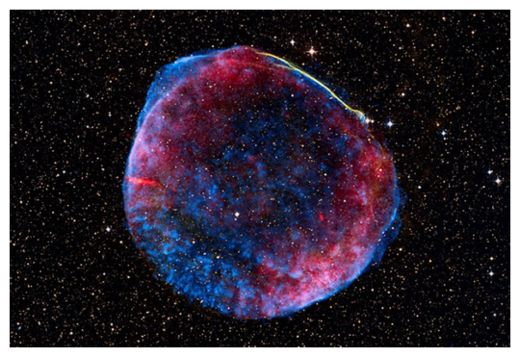
Researchers with the Harvard-Smithsonian Center for Astrophysics (CfA) have announced in a new paper that one such event has been discovered.
Supernovae are split into sub-types. While some of them can be traced to the collapse of massive stars, others arise from the accretion of mass onto a tiny white dwarf, barely more massive than our Sun, yet far more dense. The exact manner in which the supernova proceeds can further subdivide supernovae into different classes.
One of the rarest classes is known as Type Ibn. Only five previous events have ever been seen and they were all found in galaxies similar to the Milky Way - young spiral systems with significant ongoing star formation.
The working theory is that such supernovae are the result of the collapse of massive stars that had ejected massive amounts of helium prior to their collapse. The catch is such high mass stars - those on the order of 100 solar masses - do not live very long. Because of the immense gravitational pressure on their cores, the rate of fusion needed to sustain hydrostatic equilibrium is immense and they quickly burn through their nuclear fuel.
As a result, astronomers would only expect to find supernovae resulting from the collapse of massive stars in galaxies where stars are being actively created. In systems where star formation had long ceased, all of the massive stars would have already reached the end of their lives.
That is what makes the case of PS1-12sk so peculiar. Researchers, using the Pan-STARRS telescope on Haleakala, Hawaii, found this very young supernova in a bright elliptical galaxy about 780 million light-years from Earth. Such galaxies are decidedly gas poor, making them unsuited for star formation - especially for the type of massive stars needed to be the progenitors of a Type Ibn supernova.
This has astronomers wondering how this happened. "It could be that we simply got very lucky with this discovery. But luck favors the prepared," said Alicia Soderberg of the CfA, one of the authors of the study.
Another of the study's authors, John Tonry of the University of Hawaii's Institute for Astronomy, wonders, "Is this a runaway star from another star formation site? Is it a very local bit of star formation? Is it a different way for such a supernova to occur? None of these seems very likely, so we have a real puzzle."
In fact, this result has some experts wondering whether their take on these rare Type Ibn supernovae is perhaps altogether wrong. Instead of being the collapse of a supermassive star, could it be these remnants are the result of the collision of two white dwarfs, one of which was helium rich - the telltale sign of this rare type of supernova?
This assertion may have some validity as the requirements for recent star formation would be diminished since the white dwarfs could have existed in binary for millions or billions of years prior to colliding. However, some are still not willing to concede the position and suggest instead perhaps the elliptical galaxy that houses PS1-12sk is not quite down with star formation after all.
It could be the host galaxy actually does contain an active star-forming region that has, until now, simply gone undetected. Or perhaps this new source, though bearing some resemblance to previous Type Ibn events, is in fact an altogether new type.
In any case, this new source is sure to generate some exciting debate in the astrophysical community.



Supernovas are a phase of double star electrical interaction.
[Link]